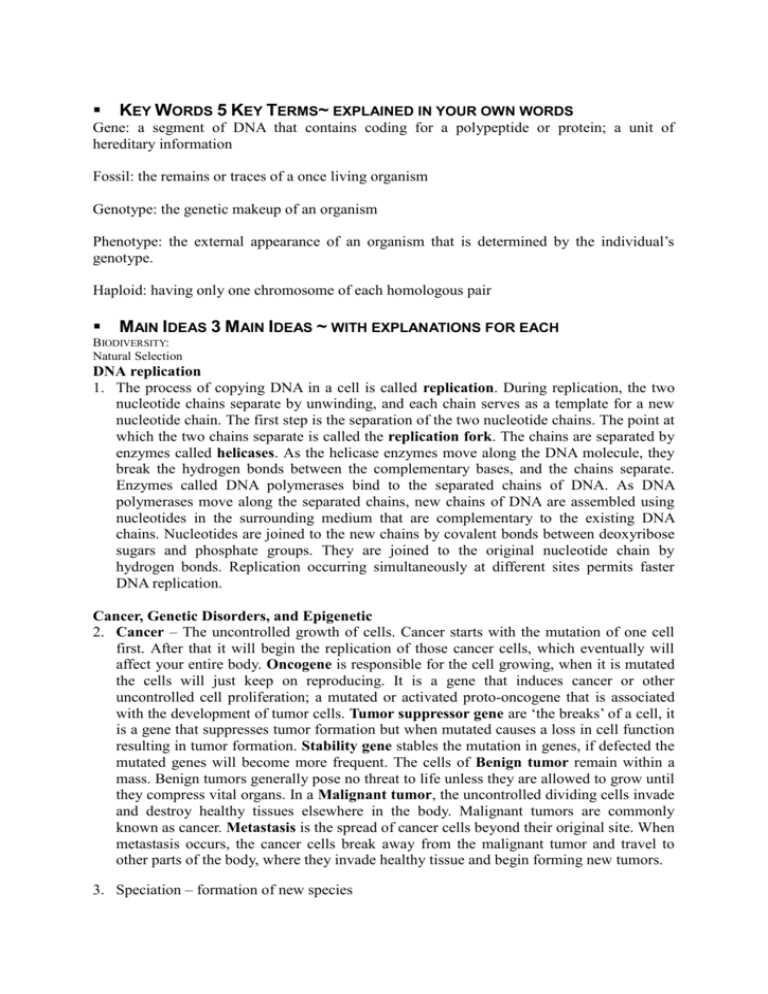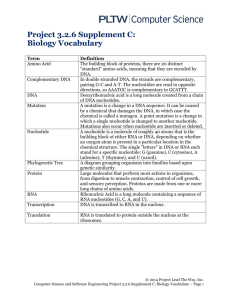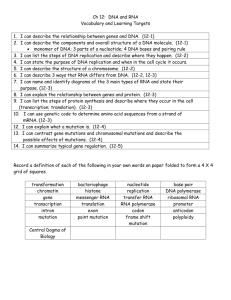Biology 1 Study Guide
advertisement

KEY WORDS 5 KEY TERMS~ EXPLAINED IN YOUR OWN WORDS Gene: a segment of DNA that contains coding for a polypeptide or protein; a unit of hereditary information Fossil: the remains or traces of a once living organism Genotype: the genetic makeup of an organism Phenotype: the external appearance of an organism that is determined by the individual’s genotype. Haploid: having only one chromosome of each homologous pair MAIN IDEAS 3 MAIN IDEAS ~ WITH EXPLANATIONS FOR EACH BIODIVERSITY: Natural Selection DNA replication 1. The process of copying DNA in a cell is called replication. During replication, the two nucleotide chains separate by unwinding, and each chain serves as a template for a new nucleotide chain. The first step is the separation of the two nucleotide chains. The point at which the two chains separate is called the replication fork. The chains are separated by enzymes called helicases. As the helicase enzymes move along the DNA molecule, they break the hydrogen bonds between the complementary bases, and the chains separate. Enzymes called DNA polymerases bind to the separated chains of DNA. As DNA polymerases move along the separated chains, new chains of DNA are assembled using nucleotides in the surrounding medium that are complementary to the existing DNA chains. Nucleotides are joined to the new chains by covalent bonds between deoxyribose sugars and phosphate groups. They are joined to the original nucleotide chain by hydrogen bonds. Replication occurring simultaneously at different sites permits faster DNA replication. Cancer, Genetic Disorders, and Epigenetic 2. Cancer – The uncontrolled growth of cells. Cancer starts with the mutation of one cell first. After that it will begin the replication of those cancer cells, which eventually will affect your entire body. Oncogene is responsible for the cell growing, when it is mutated the cells will just keep on reproducing. It is a gene that induces cancer or other uncontrolled cell proliferation; a mutated or activated proto-oncogene that is associated with the development of tumor cells. Tumor suppressor gene are ‘the breaks’ of a cell, it is a gene that suppresses tumor formation but when mutated causes a loss in cell function resulting in tumor formation. Stability gene stables the mutation in genes, if defected the mutated genes will become more frequent. The cells of Benign tumor remain within a mass. Benign tumors generally pose no threat to life unless they are allowed to grow until they compress vital organs. In a Malignant tumor, the uncontrolled dividing cells invade and destroy healthy tissues elsewhere in the body. Malignant tumors are commonly known as cancer. Metastasis is the spread of cancer cells beyond their original site. When metastasis occurs, the cancer cells break away from the malignant tumor and travel to other parts of the body, where they invade healthy tissue and begin forming new tumors. 3. Speciation – formation of new species Geographic Isolation is the physical separation of members of a population. Populations may be physically separated when their original habitat becomes divided. A deep canyon could develop, a river could change course, or a drying climate in a valley could force surviving fragments of an original population into separate mountain ranges. Once these populations are isolated, gene flow between them stops. Reproductive isolation results from barriers to successful breeding between population 3 DIAGRAMS Read from bottom to top Common feature 5 DIFFERENT THINGS WE DISCUSSED 1. Charles Darwin Charles Darwin is considered as the “Father of Evolution” He observed the various species in the Galapagos island and came up with 3 theories of evolution. Decent with Modification Survival of the Fitter Natural Selection 2. RNA RNA – ribonucleic acid. RNA is responsible for the movement of genetic information from the DNA in the nucleus to the site of protein synthesis in the cytosol. Messenger RNA (mRNA) – Consists of RNA nucleotides in the form of a single uncoiled chain. mRNA carries genetic information from the DNA in the nucleus to the cytosol of a eukaryotic cell. Transfer RNA (tRNA) – Consists of a single chain of about 80 RNA nucleotides folded into hairpin shape that binds to specific amino acids. There are about 45 varieties of tRNA. Ribosomal RNA (rRNA) – Is the most abundant form of RNA. rRNA consists of RNA nucleotides in a globular form. Joined by proteins, rRNA makes up the ribosomes where proteins are made. 3. Characteristics of living things Made out of cells (Life needs a container) Organization (Life needs a container) Use energy (Life needs a way to capture and use energy) Homeostasis - keeping in a stable condition (Life needs a way to capture and use energy) Growth, Develop (Life needs a way to encode and transfer information) Reproduce. (Life needs a way to encode and transfer information) 4. Nucleic Acids DNA is made up of repeating subunits called nucleotides, each DNA molecule consists of two long chains of nucleotides. A DNA nucleotide has 3 parts: a) a sugar molecule called the deoxyribose b) A phosphate group, which consists of a phosphorus, P, atoms surrounded by oxygen, O, atoms c) A molecule that is referred to as a nitrogen-containing base because it contains a nitrogen, N, atom. The four nitrogen-containing bases found in DNA nucleotides are adenine, guanine, cytosine, and thymine. 5. Law of Segregation and Independent Assortment Law of Segregation – States that pairs of genes separate in meiosis and each gamete receives one gene of a pair. Independent Assortment – During meiosis, the random distribution of genes from different chromosomes to the gametes. PUT IT INTO ACTION 1 EXPLANATION OF THE IMPORTANCE OF THIS TOPIC Inheritance and its effect on evolution By learning evolution and inheritance, I could understand better how humans evolved from other species. Before when I didn’t know these concepts, I wondered how it would be possible to evolve from monkeys to humans even if they look alike, but now I understand how they were able to evolve from monkeys to humans. And now when I look at any species, I first think of what it might have evolved from, and the relationship between other species.








